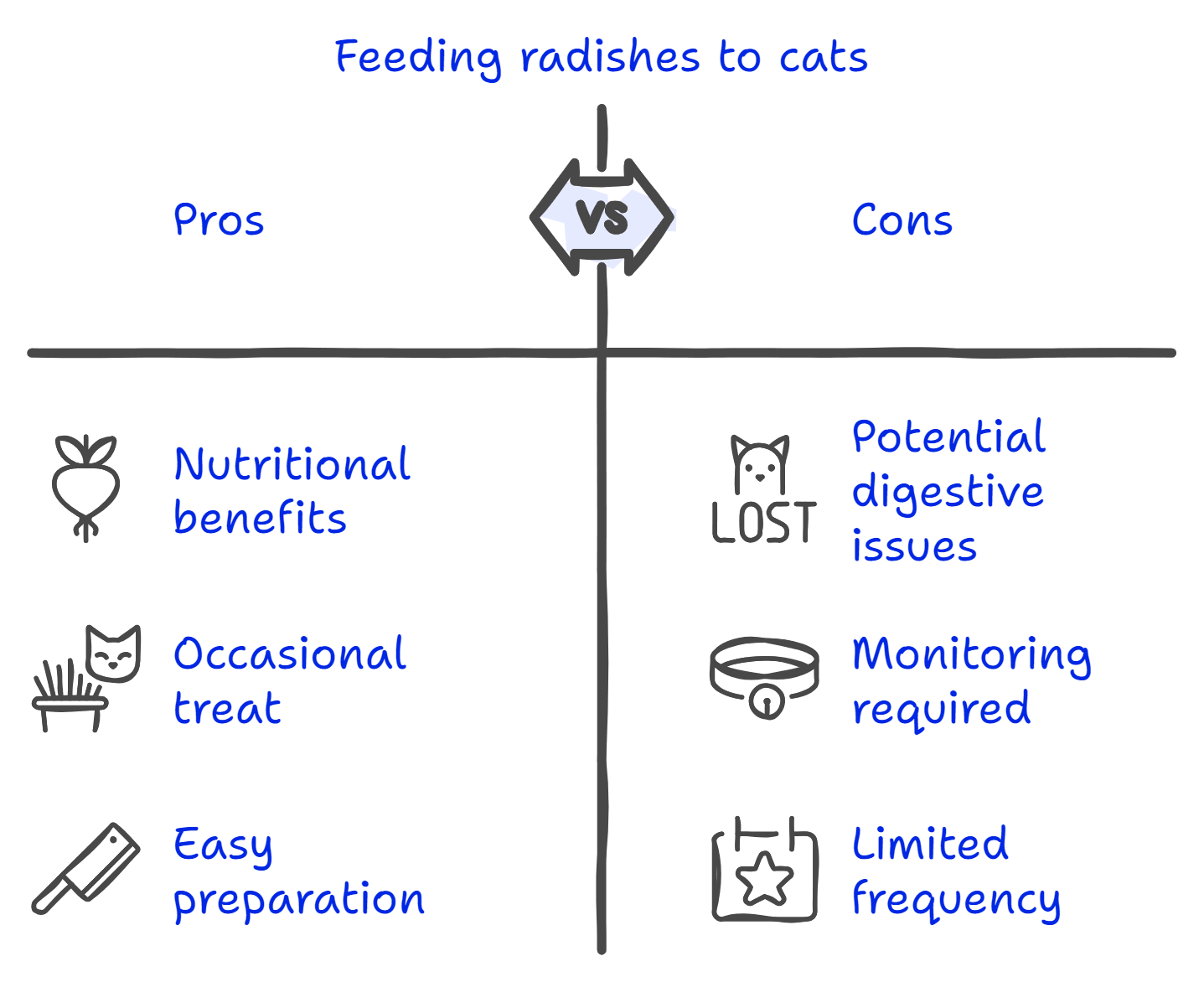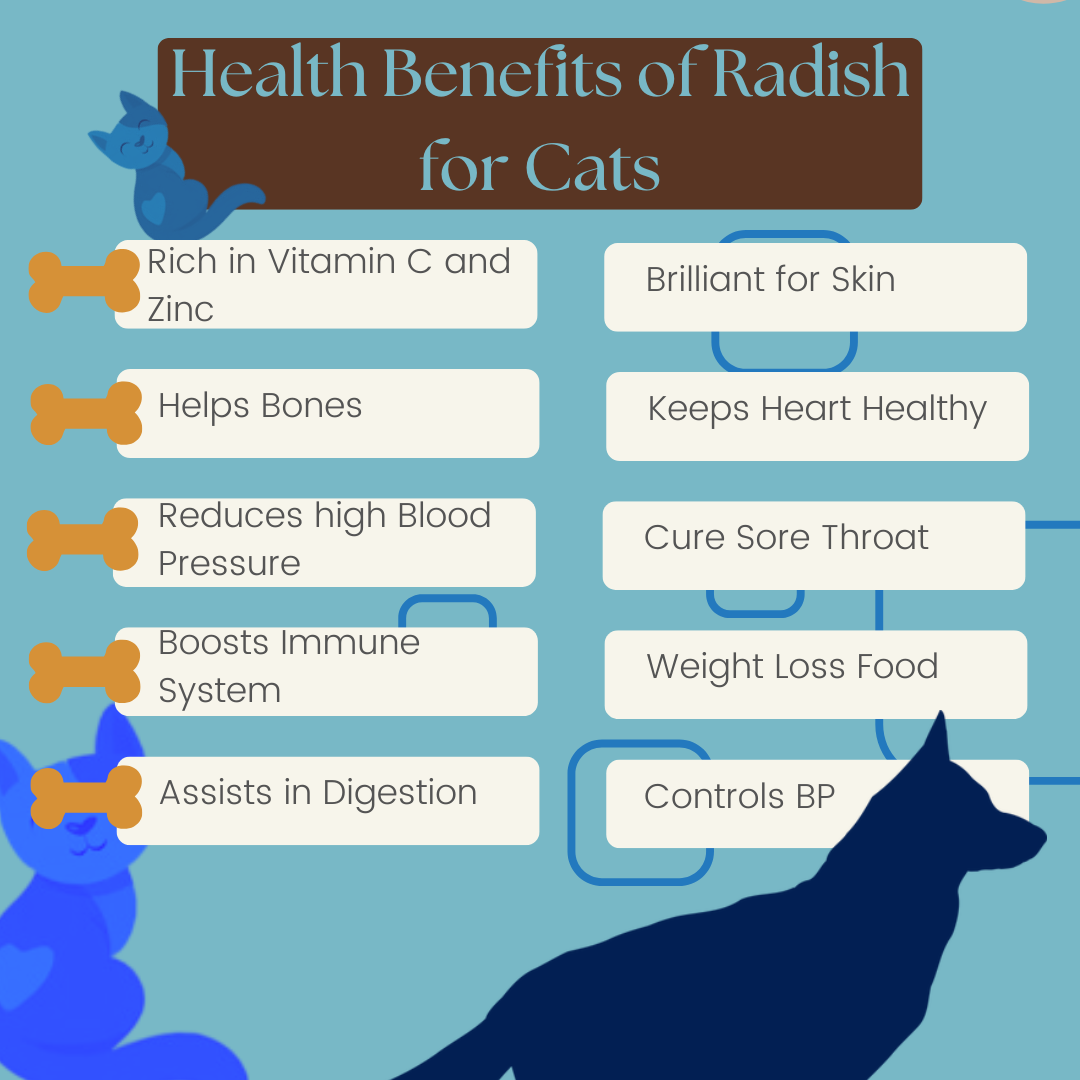Cats are picky eaters and have sensitive taste buds. As a pet owner, you might ponder what is safe for your furry companions to eat.
One common query frequently arises: “Can cats eat radishes?” or “Is it safe for your little paw friend to eat radishes?”
Well, maybe yes! Radishes are not harmful to cats. But since most cats don’t like radishes, feeding them daily is not a good idea.
However, you need to ensure that it’s okay for your cat to eat radishes before you allow them to enjoy some crisp vegetables. To find the answer, read this article through to the conclusion.

Can Cats Eat Radishes?
Well, technically speaking; radishes do not appear to contain any feline toxins in amounts high enough to be dangerous. But because it’s low in nourishment and frequently upsets the digestive system, this vegetable is generally not advised for cats.
That is assuming you can encourage your cat to eat any radishes at all! This vegetable’s unpleasant flavor turns off most pets, and refuse to eat it.
Still, if you’re looking for something healthier to feed your cat, radishes aren’t the best option. When talking about healthy vegetables, Bok Choy comes before Radishes. Here’s why!
Can Cats Eat Radish Leaves?

Luckily, radish leaves are not poisonous to cats. Therefore, you shouldn’t be too concerned if your nosy kitty steals a bite from a radish leaf in your groceries or yard. But as with the root, the leaves can disturb your cat’s stomach.
Most cats find the little spicy taste of some radish leaves to be unpleasant. Luckily, cats may find the slightly bitter taste of radish leaves off-putting, making it unlikely that they will try a second bite.
Just as you would after your cat consumes a radish root, keep an eye on its behavior and check out for any symptoms or reaction if it munches a part of the radish leaf.
How Many Radishes Should You Give Your Cat?
You should feed radishes to your cat just like any other meal. Any new dish should be introduced gradually over a minimum of a few years. The cat will benefit much from it as it gets used to the new food.
If you are determined to feed your cat radish, you must ensure that your cat does not receive excessive food in one sitting to prevent digestive issues. To begin, introduce a tiny amount of radish into their diet. While some cats might find radishes uninteresting, others might find them mildly enjoyable.
Do your cats need to be given vitamin C? Well, not at all! Because cats’ diets do not need to include vitamin C. More significantly, we might give them more vitamin C than their bodies can produce if they take supplements.
Health Benefits of Radishes for Cats
Radishes are nutritious and edible root vegetables related to cauliflower, broccoli, and cabbage. They are members of the Brassicaceae group of plants.
Although cats are typically carnivores, which means that the majority of their food should consist of meat. Adding certain vegetables, like radishes, on occasion might help them acquire extra nutrients.
Here are some potential health benefits of radishes for cats:

● Low in Calories
Because they are low in calories, radishes might be a good snack for cats prone to gaining weight. Providing low-calorie treats like radishes can aid in maintaining a healthy weight in cats.
Obesity can contribute to several health conditions, including diabetes and joint difficulties.
● Hydration
Since radishes are high in water, they can help cats stay hydrated, especially if they don’t enjoy drinking water. For cats to avoid urinary tract issues and to preserve kidney function, they must drink enough water.
● High in Fibre
The primary benefit of sometimes giving your cat radish is fiber. Like most vegetables, radishes are rich in nutritional fiber. Fibre may also aid in weight loss and the treatment of diabetes.
Because fiber is indigestible and fills the stomach without releasing calories, your cat will feel fuller while consuming fewer calories.
● Rich in Vitamins and Minerals
Vitamin C, potassium, and folate are among the essential vitamins and minerals that radishes are a good source of. These nutrients are vital for maintaining your cat’s health overall, helping cells function, and bolstering the immune system.
● Dental Health
Radishes’ crisp texture can help cats’ teeth become free of plaque and tartar by assisting with eliminating these deposits. Chewing on crunchy veggies such as radishes can help maintain your cat’s dental health in a natural way.
How To Feed Radishes To Your Cats?
While radishes can offer some health benefits for cats in moderation, it’s essential to introduce them to your feline friend safely and appropriately.
Here’s a step-by-step guide on how to feed radishes to your cats:
● Start Small
To start, feed your cat a small piece of radish to see how they respond and whether they are interested. Some cats can be more reluctant to try new foods. On the other hand, others might be curious and open to trying them.
It’s critical to honor your cat’s dietary choices and never make them eat anything they don’t want to.
● Offer as a Treat
Instead of being a regular component of your cat’s diet, radishes should only be given as an occasional treat. Serve little portions of radish alongside their usual meals as a snack or a way to commend good behavior.
After giving radishes to your cat, observe how they respond and note any variations in their behavior or feces.
● Mix with Food
Try combining radishes with your cat’s diet if they are reluctant to eat them alone. To gradually introduce the flavor to their meal, finely slice or grate the radish. This can help introduce radishes to your cat’s taste buds gradually without confusing them.
● Watch for Signs of Discomfort
After giving your cat radishes, closely monitor them for any discomfort or upset stomach symptoms. If your cat exhibits symptoms like diarrhea or vomiting, it’s best to keep away the radish in the future.
● Consult with Your Veterinarian
It is always recommended to speak with your veterinarian before adding any new items to your cat’s diet. They may offer tailored guidance according to your cat’s age, health, and dietary requirements, making sure radishes are suitable and safe for your pet.
Cat’s Diet and Nutrition
Vegetables are not necessary for cats to eat in excess. Since they must eat carnivores, their meals must be heavy in protein, moderate in fat, and low in carbs. A balanced diet should include 20%–24% fat and 26%–40% protein.
Working with your veterinarian is the best approach to determine your cat’s healthy food intake. This will remove a lot of uncertainty from the procedure and provide you with professional guidance regarding your cat’s food and dietary requirements.
FAQs
Final Thoughts
So, can cats eat radish? While radishes aren’t harmful to cats, our furry pals might not find them to be the best snack. Obedient carnivores, cats mostly eat meat as part of their diet.
Radishes and other vegetables won’t grab their interest much. Get appropriate advice from your veterinarian before giving your cat more veggies if you’re determined to do so.
Does your little paw friend like to have radishes in the diet? Let us know in the comment section below!

